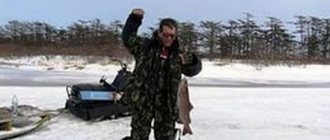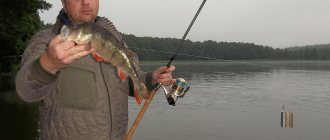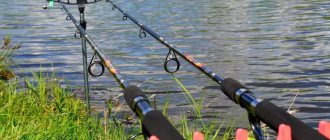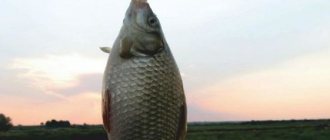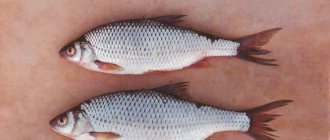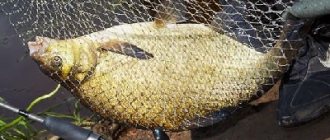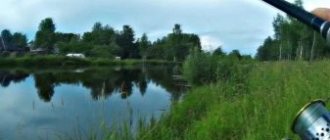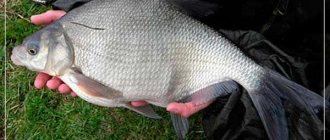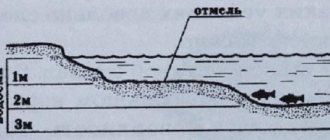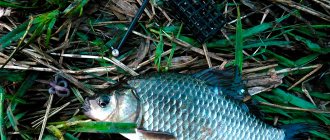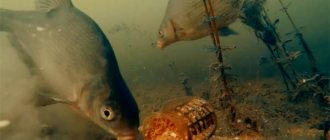Where to look for ide in the fall
Fishing for ide in the cold season is very different from summer fishing when the water is warm. Starting from the September cold snap, the fish gather in large schools and stay at great depths. Ide prefers places with calm currents and sufficient food. Summer fishing tactics are ineffective at this time. If in the summer anglers can catch fish in any part of the reservoir, the ide actively reacts to bait, then in the fall the main factor in fishing success will be the correct choice of place.
Now the determining factor is the depth at the fishing point: shallow sandy runs become empty as the fish move to more secluded areas. In the cold season, ide is localized in places with standing water and avoids channel rapids. These can be the entrances and exits from large holes and runs with a depth of more than 5 m. Various deep-water oxbow lakes that have a connection with the main river are also suitable - often the fish are located on the border of the oxbow lake and the main stream.
In addition, attention should be paid to deep turning holes that are formed as a result of a change in the direction of the main jet. In such places, located on the border of standing water and rapid currents, ide prefers to live, taking food carried by the water.
The association of ide sites with such places is determined by the presence of a large amount of food at the bottom. A small stone or snag that allows food to remain at the bottom, a compact depression at the bottom - all these places attract ide. It is also recommended to inspect shell colonies, because they not only retain food floating in the water, but they themselves are food for a large individual. The search for such places is done using standard tapping on the bottom using a jig. It helps to determine differences in depth in a reservoir. And by dragging a marker sinker, the nature of the bottom surface is studied for the presence of various objects that attract ide.
Peculiarities of ide behavior in October
The behavior of ide in October depends on the state of the natural food supply. In mid-autumn, aquatic vegetation continues to die off, and larvae and aquatic insects move deeper. Schools of small fish are concentrated in the recesses. In October, ide moves to areas with food availability.
Roaches scurry in small flocks throughout the entire water area of the reservoir, but do not rise to the surface. They focus on areas overgrown with algae, in which crustaceans and various bottom insects still remain.
Large ide stays near the bottom surface in October. It is found in areas with bottom obstacles, due to which it hunts for small fish. On well-established warm days, trophy specimens rise through drifts to shallow water. They can concentrate behind islands of dying reeds or reeds, and also visit the coastal zone in search of small fish or frogs.
Gear selection
There are a large number of ways to catch ide in the fall. Among the popular ones, the most effective are float fishing rods equipped with a simple hook or jig. In addition, you can use wobblers on ide or feeder. Another common method is fishing with a fishing rod using live bait.
Float rod
Due to the fact that this fish does not like fast-moving prey, you should opt for ide fishing gear that allows you to fish for stationary or slow-moving bait. This can be done if you use blind equipment. It is mounted on a long fly rod or on a modern plug. Recommendations for assembling a float rod:
- The rod should be light but tough. The length is selected depending on the distance to the location of the fish. Carbon fiber models up to 10 m long are suitable for fishing. If you have a special plug, you can fish at a far distance from the coastline.
- Using a line with a diameter larger than 0.18 mm is ineffective, especially if the water is clear and the fish are cautious. It is recommended to install monofilament with a thickness of about 0.15 mm. Such a thin line is also needed for better control of the equipment in fast currents.
- As a bite alarm, it is advisable to use pear-shaped or spherical floats, which are equipped with a long keel. It is better to limit the load capacity to 4 g, but if the length of the fishing line is more than 10 m, then to catch ide on a float, you can increase the weight of the equipment.
- The thickness of the leash line can be reduced, but only experienced fishermen can afford this, since it is difficult to catch ide with such a leash without experience. The hook should be chosen from thin wire size No. 10.
Spinning
Autumn fishing with spinning can be done both from the shore and from a boat. Shore fishing is preferable on small rivers, where you can easily cast under overhanging bites. Fishing from a boat in a fast current allows you to make drift movements along the current.
It is easy to fish with a spinning rod in small reservoirs in wades near the shore or its washouts. The fact is that the ide is more afraid of a person sitting on land than someone in the water. In addition, standing in the middle of the stream, it is more convenient for the fisherman to make movements and catch fish throughout the reservoir.
The smallest baits are installed, so you need to choose only among light models.
The spinning rod does not have to be long; only for fishing with long casts on a wide river or deep lake, you can consider using a long rod.
The reel should also be small or medium in size. Since when catching this predator, braided cords with a diameter of 0.11 mm are used, the reel must be appropriate. The best option would be to install a front-fraction mechanism with a medium-sized spool.
Fishing for large ide is carried out using small baits. This is due to the size of the fish's mouth, which makes it unable to swallow large prey.
The following baits are used for spinning fishing:
- Rotary spinners with “long” petals.
- Crank wobblers no longer than 5 cm.
- Microsilicone with a load of 5 g.
When fishing for ide with a spinner and a wobbler, the movements become slow and careful.
Feeder
Depending on the fishing distance and current speed, different types of fishing rods are used. In some situations, a pickerel 3 m long is suitable. If fishing is carried out in early November, then this option will be the best option.
The best fishing rod is a medium with a test weight of up to 100 g and a length of 3.6 m. With its help, an angler can fish in any part of the reservoir.
In the autumn season, the water becomes clearer, and the bites of ide, like any other fish, are careful and slow. At this time, it is recommended to use an asymmetrical loop as the main installation. As practice has shown, this rig is best suited for fishing in cold weather, when the fish are passive. In an asymmetrical loop, the feeder can easily move along the fishing line, which is important for accurate ide bites.
In addition, you need to choose the right feeder so that it moves slowly along the bottom and stops near a hole or some obstacle. It is advisable to use a braided cord with a thickness of 0.14 mm as the main fishing line. Experienced fishermen tie on a shock leader with a diameter of 0.3 mm when fishing on a shell bottom. In this case, the braid quickly frays and loses strength.
Special attention should be paid to leashes. If you can use thin cobwebs when fishing for roach, then when fishing for ide, thicker lines are selected. It is recommended to use fluorocarbon line with a thickness of 0.12 mm. It will withstand a large individual and will not curl in rings.
The length of the leash is selected depending on the speed of the water flow. You can start with leashes 40 cm long, and then, depending on the activity of the fish, tie longer or shorter leashes.
Catching ide - the most effective ways
Outwardly, ide is similar to roach, with which it is often confused by beginners who accidentally catch a small specimen. They both belong to the carp family, but unlike its close relative, ide can grow to enormous sizes. So, under favorable conditions, in particular with a good food supply, he gains weight of 5-6 kg. True, such specimens rarely end up in fishermen’s cages; most fish weighing from 1 to 2 kg are caught, but this is enough for many to hunt them purposefully. Moreover, catching ide is an exciting fishing activity that allows you to use a variety of gear, from a simple fishing rod with a float to a classic feeder. Having reached a certain age, this fish even grabs spinning baits, despite its belonging to a peaceful species.
Loyal ide will be effective only if the fisherman is well prepared for it, has set up the gear correctly, and knows the habitat of the fished object, its habits and food preferences. The desire to get such a trophy plays an important role. It should be off the charts. If you are indifferent to the process (if you bite - good, if you don’t bite - oh well), the idea is unlikely to be crowned with success. The angler’s eyes should “burn” in anticipation of a bite, then he will definitely catch the fish of his dreams.
Catching ide on the river begins with searching for a promising place. There are several areas where he likes to camp. So, ide usually holds:
Fishing technique and tactics
At the beginning of September, when there are still warm days, ide is caught using the same gear and methods as in the summer season. However, with the onset of cold weather, fish begin to gather in large schools and go to their winter camps.
For coastal fishing, you can use a light feeder or a Bolognese fishing rod. But when the fish swims to holes far from the shoreline, you can get it using a long feeder or a boat. When feeder fishing, it is important to choose the optimal composition of bait. It must contain protein supplements. Suitable baits include worms, leeches and maggots. In the fall, the ide bites are not as confident as in the spring. Therefore, cutting must be done even with a slight bend of the quivertype.
Predatory fish
For those who prefer fishing for predators, the golden time begins in October. Cold water makes the fish active and voracious. Aquatic vegetation no longer interferes with fishing with deep-sea baits. All types of predatory fish are active: pike, perch, and a little later – pike perch. In the first half of October it is still comfortable to fish from a boat, which significantly increases the chances of success.
For pike, ide and roach, the period of feeding begins in the second half of October. At this time the night begins. To catch trophy pike, large baits are used, but not only large specimens are active. Cooling water and the approach of the zhora predict a good bite throughout the month.
This is the best time to understand whether you should be a spinner or not. The probability of catching a predator is very high, and pike feed almost all day. If in the summer it has several exits during the day, and the rest of the time caress the bait, don’t caress it, it won’t do any good, then in October you can expect a bite at any time. Pike are caught using spoons, wobblers and silicone baits.
You can already try catching burbot using bottom gear. Night fishing in October for this predator will be more effective the more disgusting the weather is. The burbot bite will improve day by day and will reach its maximum by mid-November.

